

A Better Way To Reveal Fingerprints. November 6, 2012 Michael Harper for redOrbit.com – Your Universe Online Fingerprint evidence is often used in court cases to finger the guilty party.
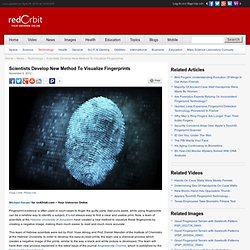
Police Chief Magazine - View Article. By Julian Fantino, Commissioner, Ontario Provincial Police, Orillia, Ontario, Canada Though offering a fundamental perspective on the many complexities of forensic science, this article is intended simply to introduce the reader to the informative articles authored by members of the IACP Forensics Committee as featured in this issue ofThe Police Chief. he evolution of law enforcement has benefited greatly from the many extraordinary advances in the field of forensic science—the application of scientific processes to solve legal problems most notably within the context of the criminal justice system.
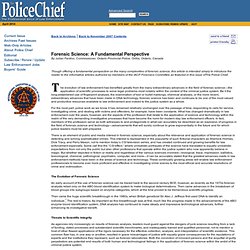
Be it the long-established use of fingerprint analysis, the examination of tool or bullet markings, chemical analyses, or the more recent, extraordinary advances that have been made in DNA technology, forensic science has been and continues to be one of the most valued and productive resources available to law enforcement and indeed to the justice system as a whole. Conclusion. Strands of Evidence. By Ari Daniel Shapiro Posted 10.11.12 NOVA scienceNOW You are what you eat, and what you eat ends up in your hair.
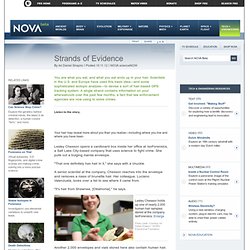
Scientists in the U.S. and Europe have used this basic idea—and some sophisticated isotopic analysis—to devise a sort of hair-based GPS tracking system. A single strand contains information on your whereabouts over the past few months, a fact that law enforcement agencies are now using to solve crimes. Listen to the story. Your hair may reveal more about you than you realize—including where you live and where you have been. Lesley Chesson opens a cardboard box inside her office at IsoForensics, a Salt Lake City-based company that uses science to fight crime.
Recent Developments in Forensic DNA. The use of DNA in forensics continues to expand.
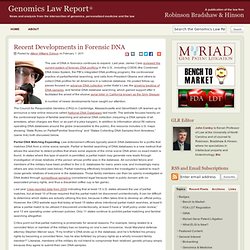
Last year, James Cass reviewed the current system of forensic DNA profiling in the U.S., including CODIS (the Combined DNA Index System, the FBI’s integrated DNA profiling program), the controversial practice of partial/familial searching, and calls from President Obama and others to collect DNA profiles for all Americans in a national database. High-Tech, High-Risk Forensics. Dnaf. DNA solves 13-year-old cold case murder mystery. SALT LAKE CITY -- Science is changing the way police officers solve cases that have remained a mystery for several years, particularly in high profile murder cases where DNA evidence was hard to obtain.

Putting up a desperate fight for her life 13 years ago, a 10-year-old girl named Anna Palmer was attacked and killed outside her front door. As she fought off her attacker, Palmer left several clues about her killer, but detectives lacked the science necessary to make the connection. The heinous crime terrorized the Salt Lake community after Palmer's mother found her dead on the front porch of the home, with five stab wounds to the throat and a severely beaten body.
One of the stab wounds severed Palmer's spinal cord. "It was such a hole in the neighborhood to have her be gone," said neighbor Rebecca Sterling. Following the murder, detectives had little to work with: there were no witnesses, no obvious evidence and no apparent suspects. Email: syi@ksl.com. Antibody Profiling Speeds Forensics. NZ at forefront of crime scene DNA testing - National News. Published: 9:59AM Thursday October 25, 2012 Source: Fairfax Source: ONE News Police like to insist the reality of forensic work during crime investigations is nothing like the slick, fast process shown on US TV shows like CSI - but real life is catching up with fiction.
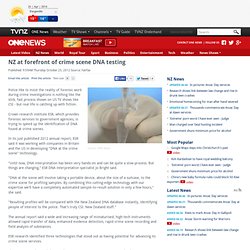
Crown research institute ESR, which provides forensic services to government agencies, is trying to speed up the identification of DNA found at crime scenes. In its just published 2012 annual report, ESR said it was working with companies in Britain and the US in developing "DNA at the crime scene" technology. Elsevier. Y chromosomes give the name away - science-in-society - 22 February 2006. Leaving DNA evidence at the scene of a crime could be tantamount to leaving your calling card, leading police to your name even if your DNA has never been recorded, a new study suggests.

Mark Jobling and colleagues at the University of Leicester, UK, recruited 150 pairs of men. Each pair shared the same British surname but were not knowingly related. The researchers analysed their Y chromosomes, which are passed directly from father to son. Painting a suspect's portrait with DNA. 6 January 2011Last updated at 02:50 By Paul Rincon Science reporter, BBC News DNA could be used to predict aspects of appearance, such as a person's hair and skin colour Police sketches are a standard part of detective work, particularly in violent crimes.
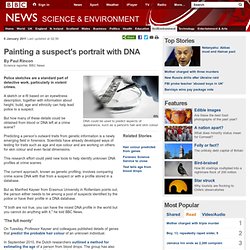
A sketch or e-fit based on an eyewitness description, together with information about height, build, age and ethnicity can help lead police to a suspect. But how many of these details could be obtained from blood or DNA left at a crime scene? Predicting a person's outward traits from genetic information is a newly emerging field in forensics. This research effort could yield new tools to help identify unknown DNA profiles at crime scenes. The current approach, known as genetic profiling, involves comparing crime scene DNA with that from a suspect or with a profile stored in a database. "If both are not true, you can have the nicest DNA profile in the world but you cannot do anything with it," he told BBC News. 'The full monty' Facing facts. NRGforensics. Forensic20yearsDNA.